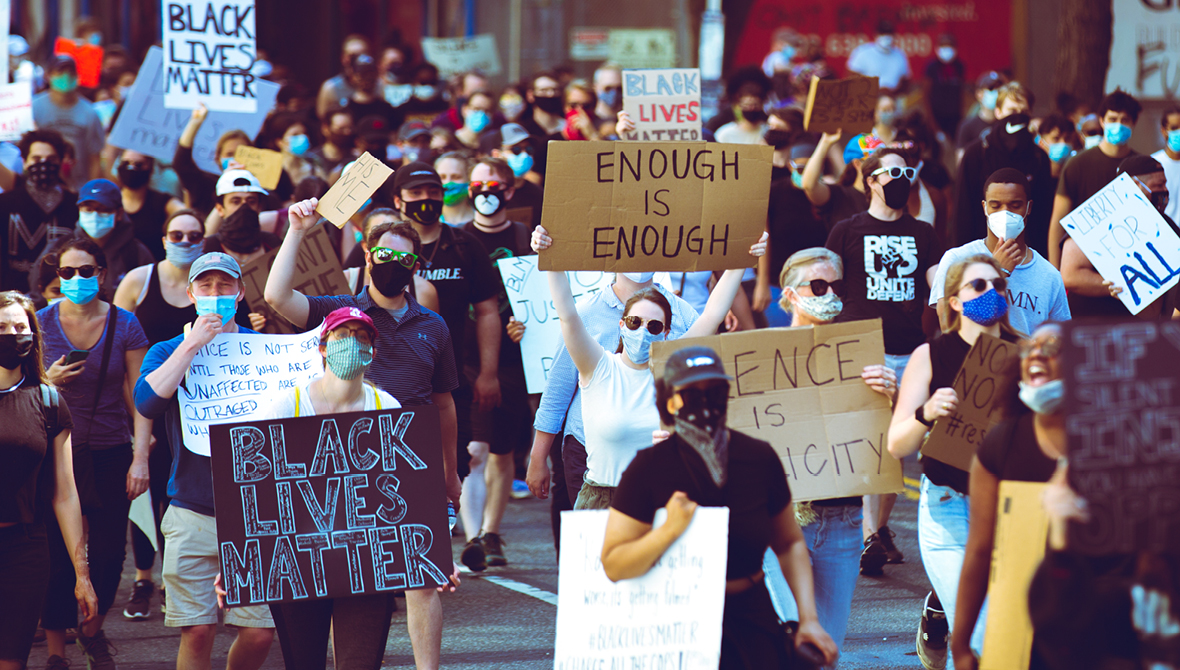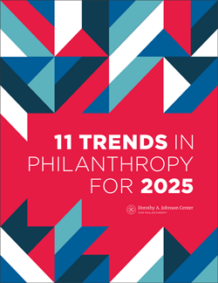Evolution and Challenges of Social Justice Philanthropy in a Polarized Era


 This article was first published in our 11 Trends in Philanthropy for 2025 report. Explore the full report here.
This article was first published in our 11 Trends in Philanthropy for 2025 report. Explore the full report here.
Want the latest trends, research, and more delivered right to your inbox? Subscribe to the Johnson Center email newsletter.
The concept of social justice has long been influenced by historical, philosophical, and religious traditions. Social justice has many definitions, but today it is broadly viewed as the effort to “seek fairness, equity, inclusion, self-determination or other goals” for historically marginalized groups (Duignan, 2024, para. 1).
Philanthropic interest in social justice surged following the brutal and unjustified murder of George Floyd by Officer Derek Chauvin in 2020. This tragedy and the coronavirus pandemic catalyzed an increase in philanthropic support for racial equity, with commitments reaching $16.5 billion in 2020 by some estimates (Bowermaster, 2024; See PRE’s “Mismatched: Philanthropy’s Response to the Call for Racial Justice” [2021] for alternative estimates and sources). However, the momentum gained in 2020 has slowed significantly, with funding levels dropping to just under $8 billion in 2021 (Bowermaster, 2024).
This decline in funding coincides with heightened political polarization and a growing backlash against social justice initiatives, particularly diversity, equity, and inclusion (DEI) efforts. The recent Supreme Court ruling striking down affirmative action has strengthened opposition, causing many philanthropic entities and institutions of higher education to retreat from prior commitments to social justice. As a result, marginalized individuals face a growing risk of losing the essential support they need to build economic and civic power and strengthen community well-being.
In 11 Trends in Philanthropy for 2023, Teri Behrens asked whether philanthropy’s response to 2020’s multiple social justice crises — “the numerous pledges, equity statements, and realignments — represent[ed] a true trend in our sector, or rather a moment in time” (para 9). One thing Behrens did not explore was whether or not philanthropy would get to answer that question for itself.
Two years on from that writing, some answers have begun to emerge while others remain unpredictable. But the influence of decision-makers outside of philanthropy is undoubtedly an enormous factor.
Shifts in public opinion regarding organizations’ engagement in social justice work appear to align with this overall decline. A Pew Research Center survey (2023) showed that while two-thirds (67%) of Americans supported the Black Lives Matter movement in 2020, opposition has risen significantly in just three years, with 46% of respondents opposed to the movement — a 15% increase (Horowitz et al).
Alongside shifting public opinion, efforts from conservative groups like the American Alliance for Equal Rights, a nonprofit organization committed to challenging racial and ethnic policy and programmatic distinctions in federal and state courts, have significantly affected the ability of organizations, companies, and institutions to incorporate social justice into their work. A notable achievement for these groups is the recent Supreme Court decision to eliminate affirmative action from college and university admissions citing violations of the Equal Protection Clause of the 14th Amendment.
The full impact of the Supreme Court’s decision remains uncertain; however, initial enrollment data for fall 2024 suggests that the ruling could significantly affect the demographics of student bodies. Both Harvard University and the University of North Carolina at Chapel Hill have reported a decrease in the number of Black first-year students in comparison to the prior year (Bailey, 2024; Ventura, 2024). Yale University, on the other hand, saw a decline in Asian American students (Talbert, 2024). At Washington University, fewer Black and Asian American students enrolled (Maglione et al., 2024) just as Brown University observed a decline in its share of first-year Black and Hispanic students (Hartocollis & Saul, 2024; LeVine, 2024). It should be noted that other universities, such as Massachusetts Institute of Technology and Columbia University, enrolled more Asian American students (Maglione et al., 2024) while other schools are having a completely different experience, which may include no changes at all (Hartocollis & Saul, 2024).
In conversations around the sector, we’re also hearing that the fear of lengthy and expensive legal battles has led many organizations to alter or eliminate programs that typically serve people of color — although it’s difficult to find publicly announced examples. The Fearless Fund, a venture capital fund, has come to stand as a proxy for what’s happening. The fund, which aimed to support Black women business owners through its Fearless Strivers Grant contest, recently closed that program to settle a lawsuit filed by the American Alliance for Equal Rights (Franklin, 2024). Although the settlement helped avoid any legal precedent that might have affected race-based or -focused grantmaking, it raises concerns about how lesser-funded or under-resourced organizations will navigate potential litigation.
Changes occurring within higher education institutions are affecting more than just college admissions and student body demographics. Tracked by The Chronicle of Higher Education, as of November 22, 2024, more than 200 college campuses have implemented changes to their DEI programming (Gretzinger et al.). These alterations, including the closure of departments, elimination of staff, and removal of training, reflect the impact of “mounting political pressure” (para. 1) and legislative changes on higher education institutions nationwide.
Eliminating successful initiatives that have helped create an academic community where individuals from various backgrounds have increased chances of success is a concern (Asmelash, 2023). For example, DEI programming can positively contribute to student retention — “particularly among students of color” (Harsha, 2023, para. 5) — and provides increased social support for LGBTQ+ learners (Schermele, 2023). As stated in an opinion piece by John Eaves (2024), “DEI is not just about race; it encompasses a broader spectrum of society, including veterans, individuals with disabilities, first-generation college students, the LGBTQ+ community and women, many of whom are white” (para. 2). One must wonder if the changes to DEI programming in higher education are a precursor of more to come in our society (Ashmelash, 2023).
Philanthropic organizations, too, are grappling with how to respond to the backlash against social justice. While some organizations remain steadfast, others have decided to distance themselves by erasing or disguising “language about commitments or programs related to racial equity from their websites and applications.” (Beaty, 2024).
It is also noteworthy that, according to research from the Center for Effective Philanthropy (2024), foundations led by people of color were far more likely than foundations with non-POC leaders to convene conversations about the implications of the affirmative action ruling internally (75% versus 49%) and with grantees (60% versus 30%) (p. 5). These gaps were equally visible within foundations that explicitly fund social justice work and those that do not — indicating that the urgency of social justice work, and comfort with managing its complexities, remains deeply uneven across the field.
As philanthropy navigates these challenges, it is crucial to reflect on and consider the broader implications for social justice work during this current period of heightened political and ideological tension in the U.S.
The current opposition to social justice is deeply unsettling for those committed to building a society where everyone has the opportunity to thrive. As we confront efforts to dismantle initiatives and organizations that offer hope, support, and encouragement to individuals who are far too often downgraded to a “lesser than” status, we must acknowledge the uncertainty of how this movement will ultimately affect us. We should be deeply concerned about its potential to reverse progress toward social justice and recognize the irreparable harm it may cause.



Asmelash, L. (2023, June 14). DEI programs in universities are being cut across the country. what does this mean for higher education? CNN. https://www.cnn.com/2023/06/14/us/colleges-diversity-equity-inclusion-higher-education-cec/index.html
Bailey, C. (2024, September 14). What college campuses look like after the end of affirmative action. CNN. https://cnn.com/2024/09/14/us/diversity-post-affirmative-action-unc-harvard/index.html
Beaty, T. (2024, February 7). As DEI policies come under legal attack, philanthropic donors consider how to adapt. The Chronicle of Philanthropy. https://www.philanthropy.com/article/as-dei-policies-come-under-legal-attack-philanthropic-donors-consider-how-to-adapt
Behrens, T. (2023, January 18). Will philanthropy stay focused on racial equity? 11 Trends in Philanthropy for 2023. Dorothy A. Johnson Center for Philanthropy at Grand Valley State University. https://johnsoncenter.org/blog/will-philanthropy-stay-focused-on-racial-equity/
Bowermaster, D. (2024, May 24). 4 years after George Floyd, racial equity giving faces challenges. Forbes. https://www.forbes.com/sites/davidbowermaster/2024/05/24/4-years-after-george-floyd-racial-equity-giving-faces-challenges/#:~:text=By%20Candid’s%20estimate%2C%20commitments%20for,2020%20levels%2C%20according%20to%20Candid
Center for Effective Philanthropy. (2024, February). How foundations are responding to the U.S. Supreme Court affirmative action rulings. https://cep.org/wp-content/uploads/2024/02/CEP_Research_Snapshot_Series_AA_FNL.pdf
Cyril, M. D., Kan, L. M., Maulbeck, B. F., & Villarosa, L. (2021, September). Mismatched: Philanthropy’s response to the call for racial justice. Philanthropic Initiative for Racial Equity (PRE). https://racialequity.org/wp-content/uploads/2021/09/0910_PRE_Mismatched_PR_infographic-1.pdf
Duignan, B. (2024, September 17). Social justice. Britannica. Retrieved October 16, 2024, from https://www.britannica.com/topic/social-justice
Eaves, J. H. (2024, November 21). We can’t let Trump dismantle college DEI efforts – Diversity, equity and inclusion programs have been politicized, but they help America live up to its founding ideals. The Atlanta Journal-Constitution. https://www.ajc.com/opinion/opinion-we-cant-let-trump-dismantle-college-dei-efforts/QEOXON3YPZBUFAMMR3NI73YKRY/
Franklin, J. (2024, September 11). A venture capital grant program for Black women officially ends after court ruling. NPR. https://www.npr.org/2024/09/11/nx-s1-5108729/fearless-fund-atlanta-grant-program-shut-down-lawsuit
Gretzinger, E., Hicks, M., Dutton, C., & Smith, J. (2024, November 22). Tracking higher ed’s dismantling of DEI. The Chronicle of Higher Education. https://www.chronicle.com/article/tracking-higher-eds-dismantling-of-dei
Harsha, D. (2024, April 2). As attacks on campus diversity programs grow, HKS researchers point to evidence that equity and inclusion programs strengthen higher ed outcomes. Ash Center for Democratic Governance and Innovation. https://ash.harvard.edu/articles/as-attacks-on-campus-diversity-programs-grow-hks-researchers-point-to-evidence-that-equity-and-inclusion-programs-strengthen-higher-ed-outcomes/
Hartocollis, A., & Saul, S. (2024, September 13). Affirmative action was banned. what happened next was confusing. The New York Times. https://www.nytimes.com/2024/09/13/us/affirmative-action-ban-campus-diversity.html
Horowitz, J. M., Hurst, A., & Braga, B. (2023, June 14). Support for the Black Lives Matter movement has dropped considerably from its peak in 2020. Pew Research Center. https://www.pewresearch.org/social-trends/2023/06/14/support-for-the-black-lives-matter-movement-has-dropped-considerably-from-its-peak-in-2020/
LeVine, T. (2024, September 6). At Brown University, Black freshman enrollment drops 40%. The Brown Daily Herald. https://www.browndailyherald.com/article/2024/09/at-brown-university-black-freshman-enrollment-drops-40
Maglione, F., Cachero, P., Choi, A., & Wahid, R. (2024, September 27). Black enrollment drops at top schools as affirmative action axed. Bloomberg Law. https://news.bloomberglaw.com/daily-labor-report/black-enrollment-drops-at-top-schools-as-affirmative-action-axed
Schermele, Z. (2023, October 20). A college LGBTQ center disappeared. it wasn’t the only one. USA Today. https://www.usatoday.com/story/news/education/2023/10/19/university-lgbtq-centers-disappearing/71147364007/
Talbert, H. (2024, September 4). In first Yale class since the end of affirmative action, Black and Latine enrollment share remains stable while Asian American decreases. Yale Daily News. https://yaledailynews.com/blog/2024/09/04/in-first-yale-class-since-the-end-of-affirmative-action-black-and-latine-enrollment-share-remains-stable-while-asian-american-decreases/
Ventura, J. (2024, September 11). Black enrollment drops in Harvard’s freshman class after Supreme Court ruling. The Hill. https://thehill.com/homenews/education/4874513-harvard-diversity-decrease-affirmative-action/